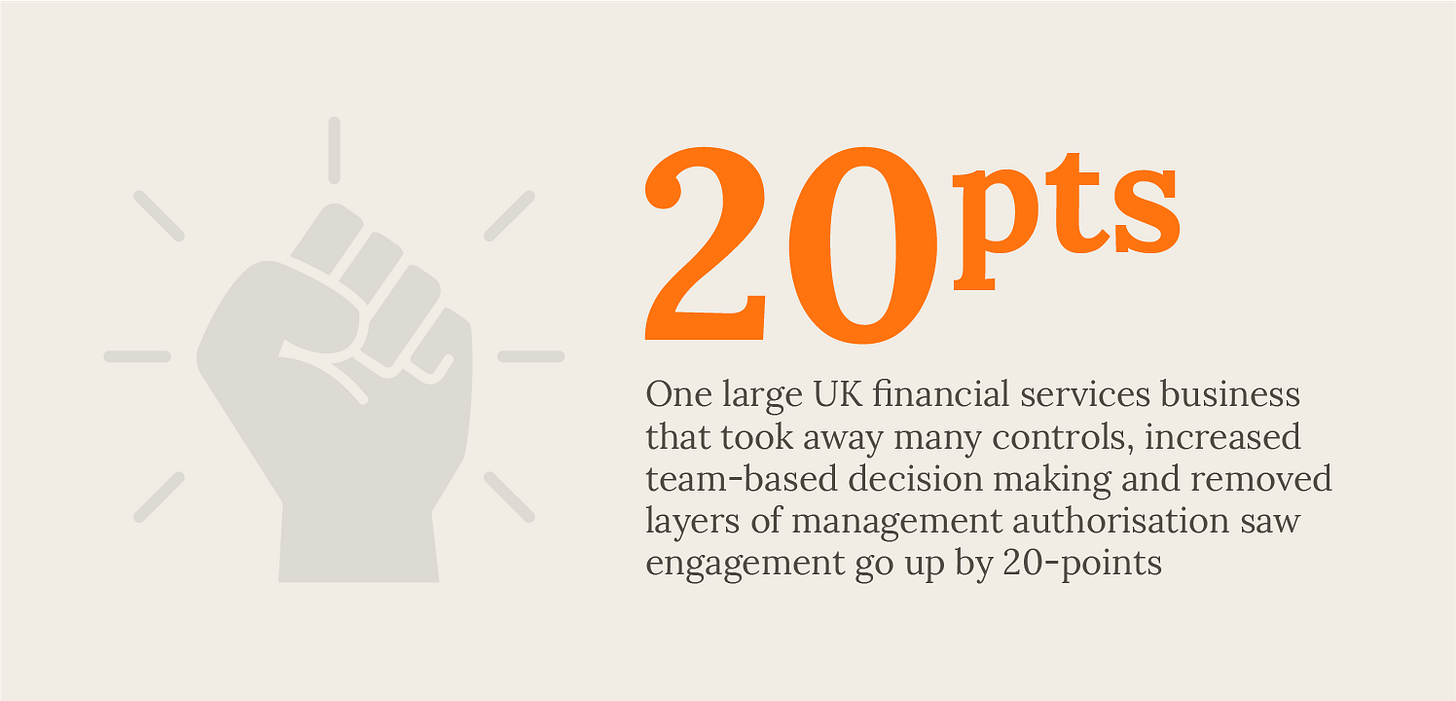Push power and choices down to help push performance up
Disempowerment is kryptonite, but empowerment transforms workplaces—boosting creativity, speeding decisions, and lifting performance in ways no perk ever could.
“Micromanagement is the destroyer of momentum.” Miles Anthony Smith, Author of Why leadership sucks
As I wrote earlier this week, employee empowerment a critical ingredient to organisational success. Disempowerment acts as the Kryptonite that drives down engagement.
However, as multiple research studies have shown, the results are clear: empowerment also makes a huge difference to business performance.
A 2018 study for the Journal of Organizational Behaviour, and reported on in Harvard Business Review (When Empowering Employees Works, and When It Doesn’t, by Allan Lee, Sara Willis and Amy Wei Tian) is one very powerful example.
Examining the results of 105 studies, included data from more than 30,000 employees from 30 countries, the authors looked at whether an empowering leadership style was linked to improved job performance.
The findings highlighted how empowering leaders drives greater employee creativity, trust and performance.
Another 2018 study, covered in the International Journal of Economics, Business and Management Research, showed how a Nigerian bottling plant significantly boosted productivity by applying employee empowerment techniques.
I’ve seen these kind of results myself. I remember how one large UK financial services business took away many controls in its contact centres, increasing team-based decision making and removed layers of management authorisation. The result? It saw engagement go up by 20-points, with attrition nose diving and call-performance metrics improving by 15%. All in one year.
This is just one example of how empowerment in highly regulated sectors can secure improved freedom in people's jobs and, as a result, improve engagement and performance.
One of the fastest routes to empowering employees is to drive greater accountability and autonomy amongst the workforce. Autonomy has been shown to lighten any negativity felt by customer-service employees doing stressful work. According to Steve Maier, a psychology and neuroscience professor at the University of Boulder, stressors we can’t control are far more damaging than stressors we feel we have some control over.
The achievement of empowerment via autonomy also eases the path towards innovation. If high-performing employees are able to freely flex their creativity and not fear reprisal they start to innovate. Indeed, many companies have started to allow their employees to define their own responsibilities and to focus on their interests; 3M gave its employees 15% of the working week to work on projects inherently interesting to them – cue the Post-It Note.
Don’t just take my word for it
The data from Ipsos Karian and Box does not sit in an isolation. If you need other evidence to help prove the critical role of empowerment in driving performance, just take a look at the below.
I’ve reviewed a range of sources to provide a quick summary of the evidence to show where and how empowerment can make the difference. For validation, I’ve added the sources that underpin each fact.
Empowerment helping drive positive culture
Empowered employees make faster decisions: A study by Harvard Business Review found that teams with decision-making autonomy resolve issues 50% faster than those requiring managerial approval, reducing delays and accelerating outcomes. Source: “The Empowerment Paradox,” HBR (2021).
Autonomy drives Innovation: Research from the University of Amsterdam revealed that employees with autonomy are 45% more likely to propose innovative ideas, directly contributing to productivity gains. Source: De Spiegelaere et al., "Autonomy and Innovation" (2018).
Empowered employees help secure more efficiency
Flatter structures improve efficiency: Deloitte’s 2020 survey found that organizations with decentralized decision-making structures complete projects 22% faster due to fewer bureaucratic layers. Source: Deloitte, “Global Human Capital Trends” (2020).
Grassroots ideas fuel efficiency: Toyota’s “Kaizen” system, which empowers workers to suggest improvements, generates 1 million+ ideas annually, saving the company $400 million per year. Source: Liker, “The Toyota Way” (2004).
Job ‘ownership’ cuts waste: A World Economic Forum study found that teams with control over resources reduce waste by 18% by aligning spending with efficiency goals. Source: WEF, “Future of Work Report” (2021).
More empowerment at work leads to more productive workplaces
Frontline empowerment reduces downtime: McKinsey found that organizations empowering frontline workers to solve problems without escalation reduce operational downtime by 30%. Source: McKinsey & Company, “The Power of Empowerment” (2022).
Empowerment driving job satisfaction which, in turn, boosts output: A meta-analysis in the Journal of Organizational Behavior linked empowerment to 31% higher job satisfaction, correlating with a 17% increase in individual productivity. Source: Seibert et al., “Empowerment and Performance” (2011).
Empowerment is a key factor in improving employee and customer outcomes
Customer satisfaction rises with empowerment: A Harvard Business School study showed that empowered customer service teams achieve 20% higher customer retention, driving revenue growth. Source: Heskett et al., “The Service-Profit Chain,” HBR (2008).
Empowerment reduces burnout: The American Psychological Association found that empowered employees report 35% lower stress levels, leading to fewer sick days and consistent productivity. Source: APA, “Workplace Empowerment and Stress” (2021).
Empowered employees are more engaged ones: Ipsos Karian and Box identified a direct link between empowerment and engagement – with more empowered employees being over 48%pts more engaged than their disempowered peers. Source: Ipsos Karian and Box global benchmark data, (2019)
What does this all mean for leaders?
Put simply, employers need to think about how to harness the ideas and input of their people if they are to truly motivate and engage them.
But also, in an economy where agility and innovation are critical, empowering teams leads to faster decisions and more ideas from them. In the market competition for talent, creating and offering a culture of involvement is key to not only finding the best people to join, but in keeping them.






Which then leads us to the question, how do we decide what layers to remove, how do we identify where colleagues don't feel empowered? How do we keep guardrails in place, mitigate risk but allow for innovation?
I've worked with teams who have applied the 15% 3M idea and they've loved it.